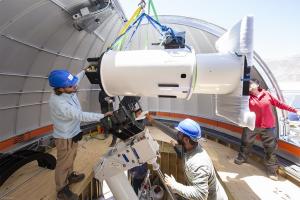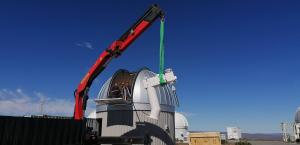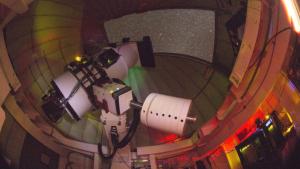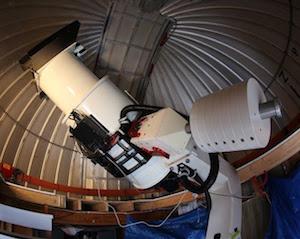Just Look Up: Expanded UH asteroid tracking system can monitor entire sky
University of Hawaiʻi at MānoaLink to video (details below): https://bit.ly/3KRqMpM
A state-of-the-art asteroid alert system operated by the University of Hawaiʻi Institute for Astronomy (IfA) can now scan the entire dark sky every 24 hours for dangerous bodies that could plummet toward Earth.
The NASA-funded Asteroid Terrestrial-impact Last Alert System (ATLAS) has expanded its reach to the southern hemisphere, from two existing northern-hemisphere telescopes on Haleakalā and Maunaloa. Construction is now complete and operations are underway on two additional telescopes in South Africa and Chile.
"An asteroid that hits the Earth can come at any time from any direction, so ATLAS is now all the sky, all the time," said IfA Professor and ATLAS Principal Investigator John Tonry.
The new telescopes are located at Sutherland Observing Station in South Africa and El Sauce Observatory in Chile. These locations were selected not only for their access to the southern part of the sky but also their time difference from Hawai‘i — they are able to observe at night when it is daytime in Hawai‘i. The four-telescope ATLAS system is now the first survey for hazardous asteroids capable of monitoring the entire dark sky every 24 hours. The modest-sized telescopes can image a chunk of sky 100 times larger than the full moon in a single exposure.
The ATLAS system can provide one day's warning for a 20-meter diameter asteroid, capable of city-level destruction. Since larger asteroids can be detected further away, ATLAS can provide up to three weeks’ warning for a 100-meter asteroid, capable of wide regional devastation. An asteroid that large could produce 10 times the destruction of the recent Hunga Tonga volcano eruption if it were to strike the Earth.
UH developed the first two ATLAS telescopes in Hawaiʻi under a 2013 grant from NASA’s Near-Earth Objects Observations Program, now part of the Planetary Defense Coordination Office (PDCO). The two facilities, on Haleakalā and Maunaloa, became fully operational in 2017.
First light and first discovery in Southern Hemisphere
After several years of successful operation in Hawaiʻi, IfA proposed for additional NASA funds to build two more telescopes in the southern hemisphere. IfA sought partners to host these telescopes, and selected the South African Astronomical Observatory (SAAO) in South Africa and a multi-institutional collaboration in Chile. The ATLAS presence augments already substantial astronomical capability in both countries.
Despite delays due to COVID-19 travel restrictions and supply-chain complications, the UH ATLAS team remotely supervised the assembly of the ATLAS telescopes in coordination with international collaborators in South Africa and Chile. In South Africa, the construction effort was led by the SAAO, and in Chile the team consisted of multiple partners, including the Millennium Institute for Astrophysics (MAS) and Obstech, which operates the private El Sauce Observatory.
On January 22, ATLAS-Sutherland in South Africa discovered its first near-Earth object (NEO), 2022 BK, a 100-meter asteroid that currently poses no threat to Earth. To date, the ATLAS system has discovered more than 700 near-Earth asteroids and 66 comets, including detection of 2019 MO and observations of 2018 LA, two very small asteroids that actually struck the Earth. The system is specially designed to detect objects that approach very close to Earth - closer than the distance to the Moon, about 240,000 miles or 384,000 kilometers away.
“The need to observe the Southern Hemisphere sky and expand the time zone coverage of ATLAS, together with the pristine skies and local human resources of Chile, made it ideal for one of the new telescopes to be in our country,” said Alejandro Clocchiatti, a MAS associate researcher, Pontificia Universidad Católica de Chile professor, and co-leader of ATLAS-Chile.
Diverse telescope interconnection
In South Africa, the ATLAS facility joins an array of world-class telescopes at the SAAO’s Sutherland Observing Station, led by the Southern African Large Telescope (SALT). “We are very excited to join the ATLAS network and to become part of the global effort to identify potentially hazardous asteroids. The additional spin-off of other astronomical transient discoveries that ATLAS offers is also perfectly commensurate with the SAAO’s flagship Intelligent Observatory project that aims to modernize, fully robotise, and interconnect the diverse telescopes on our plateau in order to achieve rapid follow-up observations of all transients in the southern night sky,” said SAAO astronomer and leader of ATLAS-Sutherland, Dr. Nic Erasmus.
Although ATLAS is funded specifically to search for NEOs, data from the ATLAS telescopes have become one of the preeminent surveys for many other astronomical phenomena. Researchers have used the system’s rich dataset, scanning the entire sky, to discover striking events far beyond our solar system. The ATLAS team collaborates with Queen’s University Belfast to search for exploding stars and other exotic short-lived events.
While the two new ATLAS telescopes have begun early science operations, they are not yet fully operational. Depending on weather, several weeks to months are needed to completely calibrate the system for maximum sensitivity and reliability. After that, the ATLAS system will typically discover a new close-approaching NEO every few days.
The new ATLAS telescopes join existing ground-based surveys as well as other next-generation ground-based NEO detection systems in the works. According to Larry Denneau, ATLAS Co-Principal Investigator, “Fortunately, NEO-hunting is a cooperative global effort, and the enhanced ATLAS complements the existing ground-based NEO search programs, namely UH’s own Pan-STARRS and the Catalina Sky Survey in Tucson, Arizona. All these systems have different specialties, and together they are working to keep us safe from hazardous asteroids that could strike anywhere from days to decades into the future.”
More about ATLAS system
The international ATLAS team is led by the University of Hawaiʻi Institute for Astronomy, whose work is supported by NASA. The Chilean station is funded in part by the Millennium Institute for Astrophysics (MAS), and is located at El Sauce Observatory, which is operated by ObsTech, with academic partners at Universidad Andrés Bello, Universidad de Chile, Pontificia Universidad Católica de Chile, Universidad Adolfo Ibáñez, and the European Southern Observatory. The Sutherland station in South Africa is built and operated by the South African Astronomical Observatory (SAAO), a facility of the National Research Foundation of South Africa.
VIDEO: (:58)
0:00-0:58 - Generic animation of asteroids (Credit: NASA)




